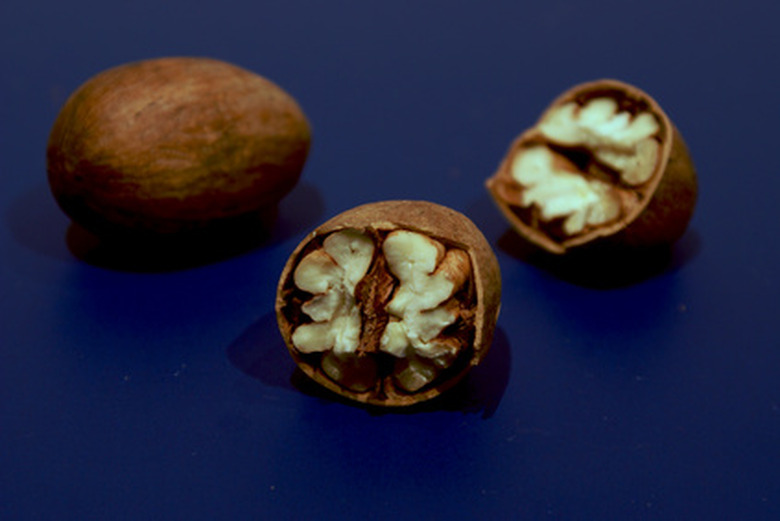Insects That Harm Pecan Trees
The pecan tree (Carya illinoinensis) is the official tree of the state of Texas and is desirable for its large size, bright green leaves and, of course, delicious nuts. The production of those nuts can be reduced or damaged, however, if the pecan tree is attacked and infested by insect pests, which feed on the sap and even use the nuts to house their young.
Hickory Shuckworm
Hickory shuckworm is a major pest to pecan trees. This insect harms the pecans of the tree and attacks midway through the season. The larvae tunnel into the shucks of the nuts, stopping the flow of nutrients and interfering with kernel development. The pecans end up malformed and immature, or they drop prematurely from the tree.
Treat affected trees with an insecticide. Because the effects of this insect are sometimes hard to spot at first, it is a good idea to spay the tree with a preventative pesticide or insecticide in the spring, before the nuts begin to develop.
- The pecan tree (Carya illinoinensis) is the official tree of the state of Texas and is desirable for its large size, bright green leaves and, of course, delicious nuts.
- The production of those nuts can be reduced or damaged, however, if the pecan tree is attacked and infested by insect pests, which feed on the sap and even use the nuts to house their young.
Stink and Leaf-footed Bugs
Stink bugs and leaf-footed bugs love to feast on pecans. These insects overwinter under fallen leaves, only to emerge in the spring and lay eggs on nearby crops, such as soybeans, or common weeds. When the eggs hatch, the larvae make their way to nearby pecan trees, where they latch onto the developing nuts and suck out the sap. If the shells of the pecans are not yet hard, the nuts will drop prematurely from the tree. If the shells have hardened, dark spots will appear on the kernel, and the pecan will develop a bitter taste.
These pests are easily spotted with the naked eye. Once spotted, the tree should be treated with a powerful insecticide to kill the insects.
- Stink bugs and leaf-footed bugs love to feast on pecans.
- If the shells have hardened, dark spots will appear on the kernel, and the pecan will develop a bitter taste.
Black Pecan Aphid
The black pecan aphid can devastate a pecan tree in just one season. These aphids suck the sap from the bottom, or underside, of the leaves of the tree. Black aphids are more dangerous to the tree than yellow aphids because they inject a toxin into the leaves when they pierce the leaves to suck out the plant's juices. The toxin kills the tissue between the veins of the leaves, first turning it bright yellow, then brown. In this way, defoliation can quickly occur, especially since it only takes three of these tiny bugs to kill one leaf, according to horticulturists with Texas A&M University.
Defoliation of a pecan tree greatly reduces nut development and production. Black pecan aphid infestations should be prevented with the application of a preventative insecticide in the spring.
- The black pecan aphid can devastate a pecan tree in just one season.
- Black aphids are more dangerous to the tree than yellow aphids because they inject a toxin into the leaves when they pierce the leaves to suck out the plant's juices.
Sawfly
Sawflies look similar to tiny bees. Their larvae are voracious eaters and will consume the leaves of the pecan trees, leaving them full of holes or ragged along the edges. Often, entire leaves are eaten. When the larvae are satiated, they drop to the soil, where they burrow into it and overwinter. In the spring, the adults lay eggs on the newly emerging leaves, continuing the cycle. Pecan trees should be sprayed with insecticide in the spring to kill the larvae before they hatch or shortly thereafter.
Fall Webworm
Fall webworm is a type of caterpillar. Hundreds of these can build large webs on a pecan tree, swathing the tree in sheets of white silk. These caterpillars consume the leaves of the tree and can defoliate even large trees in one growing season, which severely limits nut production. Between two and four generations of caterpillars can infest pecan trees each year.
- Sawflies look similar to tiny bees.
- Their larvae are voracious eaters and will consume the leaves of the pecan trees, leaving them full of holes or ragged along the edges.
